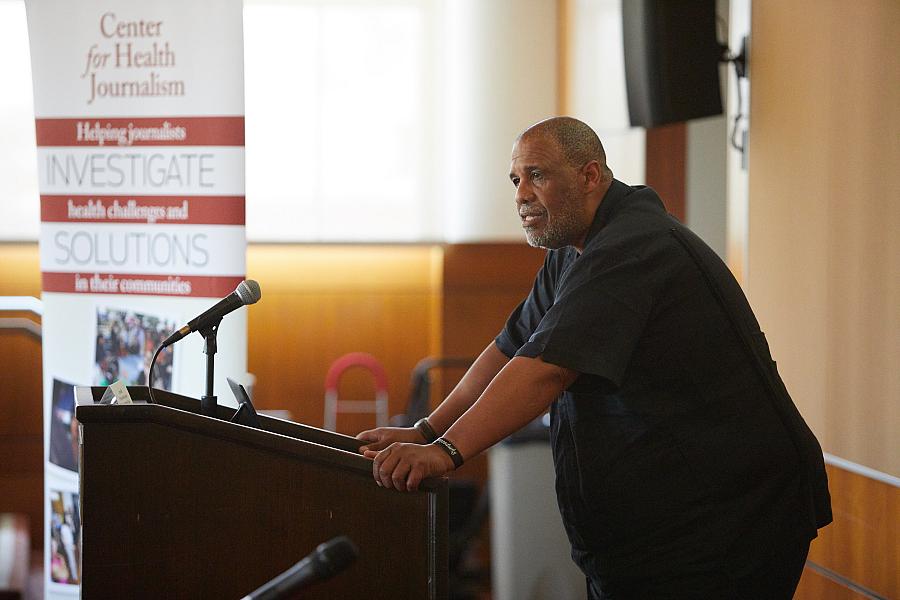How do we keep youth of color out of the juvenile justice system?

James Bell, founder and president of the W. Haywood Burns Institute, talks to 2018 National Fellows this week.
The American justice system lacks empathy and is more likely to criminalize children of color instead of understanding their behavior, a leading juvenile justice advocate told a group journalists from across the nation this week.
But health care workers and teachers can play an instrumental role in addressing youth behavior and steering wayward kids into community programs before it's too late, said James Bell, the founder and president of the W. Haywood Burns Institute.
The Oakland-based institute has worked in more than 200 counties in 23 states to encourage communities to eliminate racial and ethnic discrimination in the criminal justice system. Bell's comments on the unequal detention and discipline of youth of color were delivered at the USC Center for Health Journalism's 2018 National Fellowship. This year’s program focuses on vulnerable children and families, and the community conditions and experiences that threaten their well-being.
Bell said the growing movement among health care workers to dig deeper into “social determinants” — factors such as a person’s employment status, their housing situation, literacy levels, access to nutritious food, social interaction and quality of health care — can be a child's last chance to receive help in a society quick to misunderstand behavior that might have deeper causes — hunger, for example.
“Our legacy in the use of the power of justice in this country is … driven by racialized social control,” Bell said. “We have criminalized social problems, because we as a country are addicted to incarceration as the primary instrument of social control.”
Bell listed several examples of social control from American history. Lakota youth were taken from their homes and placed in boarding schools, “never parented, never grandparented.” They lost their language and exposure to their culture, Bell noted. Former slaves were “leased” so they would remain under some control. Mexican-Americans were deemed intellectually inferior by so-called “studies” and the notion was enforced by some local governements, which placed Latino youth in institutions. The Chinese Exclusion Act, a federal law passed in 1882, prohibited all immigration of Chinese laborers.
There are 2.3 million people incarcerated across the nation, but that figure only includes prisons, not jails or those who are somehow part of the criminal justice system. In reality at least 14 million people are locked up or caught in the criminal just system across the nation, Bell said.
Our current politics are only compounding the country’s incarceration crisis, according to Bell. During the presidential campaign, then-candidate Donald Trump told a crowd: “When Mexico sends its people, they’re not sending their best. They’re not sending you. They’re not sending you. They’re sending people that have lots of problems, and they’re bringing those problems with us. They’re bringing drugs. They’re bringing crime. They’re rapists. And some, I assume, are good people.”
Feeling safe at home, in the community, and in the country is a basic need among all humans, Bell said. But Trump and others use fear to empower the criminal justice system, he noted.
“Fear is so powerful it works everytime,” Bell said, “even if we don’t want it to work.”
Bell pointed to a study that found that black youth are seen by police officers as less childlike than their white peers. They are perceived as older than their age when first spotted by police and thus deemed more culpable and less innocent, he added.
Across the nation, 60 percent of county funding goes toward public safety on average. In Pima County, in the south-central region of Arizona, for example, officials spent $187 million to incarcerate people in 2005. Almost a decade later, that figure rose to $266 million, a 42 percent increase.
State’s such as California have tried to decrease those incarceration costs. Voters approved Proposition 47, also known as the Safe Neighborhoods and Schools Act, which allows six nonviolent felonies — such as simple drug possession or theft under $950 — to be changed to misdemeanors on old criminal records. Proponents have said the measure, passed in 2014, helps to save money by steering people out of jails. Critics say that without the threat of incarceration, theft is rising and too many people are skipping drug treatment. An effort is under way among state legislators to amend the measure, but Bell said even if it’s scrapped, remnants of the policy will remain, which has helped to keep people out of jails.
But Bell says there is no easy solution to the youth incarceration problem until society confronts its past and works to understand the deep, honest truth about racism.
“How do we deal with these truths?” Bell said. "How do we bring a cure to a disease we pretend we don't have?”
**
[Photo by Jeff Skeirik/Center for Health Journalism]

